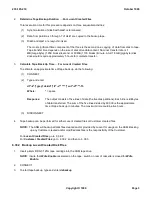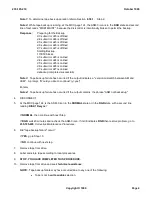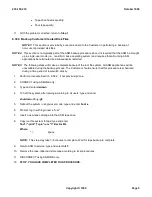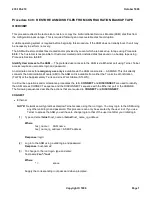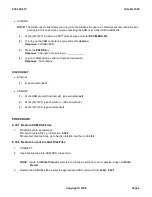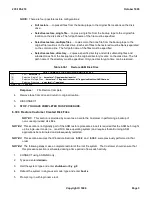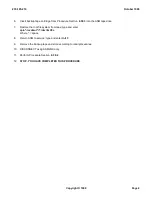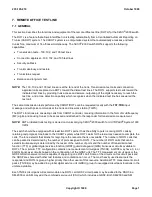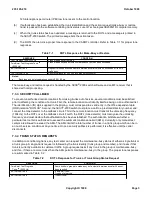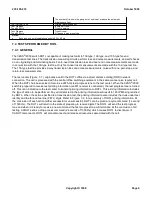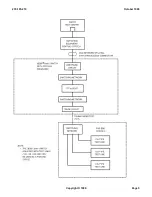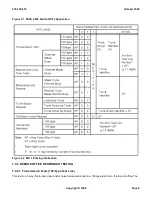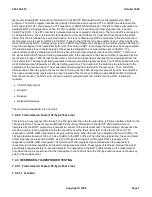
120-interruptions per minute (IPM) low tone is sent to the control location.
(b)
If authorization has been established, the trunk identification and the action request (make-busy or restore
trunk) is passed to the software controlling trunk status Lucent Technologies 3B20D/21D computer memory.
(c)
When the trunk status has been updated, a message is returned to the ROTL and a message is printed in
the
5ESS
®
-2000 switch. The printed message lists the action taken.
(d)
The ROTL then returns a proper tone response to the CAROT controller. Refer to Table 7-1 for proper tone
responses.
Table 7-1
ROTL Response for Make-Busy or Restore
RESPONSE
CONDITION
Test Progress Tone-2225 Hz
Trunk made busy or restored.
Two Burst Test Progress Tone
a
(2225 Hz)
Trunk made busy and automatic maintenance limit has been exceeded.
60-IPM Low Tone
Request refused because automatic maintenance limit would be exceeded or trunk is
traffic busy.
120-IPM Low Tone
Security callback for ROTL unlock was not successful.
Notes:
a.
Each tone and quiet separation period is 520
80 ms.
The make-busy and restore request is handled by the
5ESS
®
-2000 switch software and an MF receiver that is
shared with call processing.
7.3.3 SECURITY CALLBACK
To prevent unauthorized remote locations from taking trunks out of service, several conditions must be satisfied
prior to affecting the condition of a trunk. First, the remote location must identify itself as being on an authorized list.
The identification (ID) digit, supplied in the priming, must correspond to a valid entry in the office dependent data
(ODD) relation "ROTLCB". Second, the
5ESS
®
-2000 switch must place a call to a prestored directory number and
connect the tone detector to the callback circuit. Third, the remote location must transmit the unlocking frequency
(1004 Hz) to the ROTL over the callback circuit. Fourth, the ROTL (tone detector) must recognize the unlocking
frequency and must declare that authorization has been established. The authorization list states whether a
particular test center is authorized to exceed the automatic maintenance limit (AML). Currently, only manual test
centers are allowed to exceed the AML. The AML limits the total number of trunks in a trunk group which can be in
an out-of-service condition at any one time. Once a security callback is performed, it is effective until the caller
disconnects.
7.3.4 TRUNK STATUS REQUESTS
In addition to conditioning trunks, any test center can request the maintenance-busy status of either a single trunk or
a trunk group. A single-trunk request is followed by the trunk identity (trunk group and member), and it asks if that
trunk is currently available to customer traffic. A group request asks if any trunk in the group is maintenance-busy,
and if so, if there are more trunks than the AML permits maintenance-busy in the group. The proper tone responses
are summarized in Table 7-2 .
Table 7-2
ROTL Response for Trunk or Trunk Group Status Request
RESPONSE
CONDITION
Two Burst Test Progress
Tone
a
(2225 Hz)
Some trunks in group are made busy, but automatic maintenance limit has not
been reached.
60-IPM Low Tone
Individual Trunk -
Trunk out of service.
60-IPM Low Tone
Trunk Group -
235-105-210
October 1999
Copyright © 1999
Page 3
Summary of Contents for 5ESS-2000
Page 96: ...235 105 210 October 1999 Copyright 1999 Page 2 ...
Page 184: ...235 105 210 October 1999 Copyright 1999 Page 3 ...
Page 300: ...13 STOP YOU HAVE COMPLETED THIS PROCEDURE 235 105 210 October 1999 Copyright 1999 Page 55 ...
Page 339: ...7 STOP YOU HAVE COMPLETED THIS PROCEDURE 235 105 210 October 1999 Copyright 1999 Page 13 ...
Page 342: ...235 105 210 October 1999 Copyright 1999 Page 2 ...
Page 359: ...235 105 210 October 1999 Copyright 1999 Page 5 ...
Page 609: ...2 STOP YOU HAVE COMPLETED THIS PROCEDURE 235 105 210 October 1999 Copyright 1999 Page 12 ...
Page 676: ...235 105 210 October 1999 Copyright 1999 Page 9 ...
Page 792: ...3 STOP YOU HAVE COMPLETED THIS PROCEDURE 235 105 210 October 1999 Copyright 1999 Page 9 ...
Page 799: ...Figure 11 36 3 1 Cleaning Points 235 105 210 October 1999 Copyright 1999 Page 7 ...
Page 801: ...235 105 210 October 1999 Copyright 1999 Page 9 ...
Page 839: ...2 STOP YOU HAVE COMPLETED THIS PROCEDURE 235 105 210 October 1999 Copyright 1999 Page 16 ...
Page 999: ...2 STOP YOU HAVE COMPLETED THIS PROCEDURE 235 105 210 October 1999 Copyright 1999 Page 13 ...
Page 1008: ...Figure 11 55 1 CTSNS DIP Switch Settings 235 105 210 October 1999 Copyright 1999 Page 2 ...
Page 1011: ...235 105 210 October 1999 Copyright 1999 Page 5 ...
Page 1053: ...235 105 210 October 1999 Copyright 1999 Page 15 ...
Page 1289: ...Figure 15 17 2 AMATPS Data Link 235 105 210 October 1999 Copyright 1999 Page 2 ...
Page 1292: ...235 105 210 October 1999 Copyright 1999 Page 5 ...
Page 1303: ...9 STOP YOU HAVE COMPLETED THIS PROCEDURE 235 105 210 October 1999 Copyright 1999 Page 2 ...
Page 1360: ...Figure 15 47 2 Typical SCANS III Link Diagram 235 105 210 October 1999 Copyright 1999 Page 2 ...
Page 1372: ...235 105 210 October 1999 Copyright 1999 Page 2 ...
Page 1374: ...235 105 210 October 1999 Copyright 1999 Page 4 ...
Page 1421: ...Table 1 1 O M Checklist 235 105 210 October 1999 Copyright 1999 Page 3 ...






